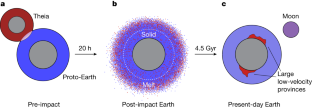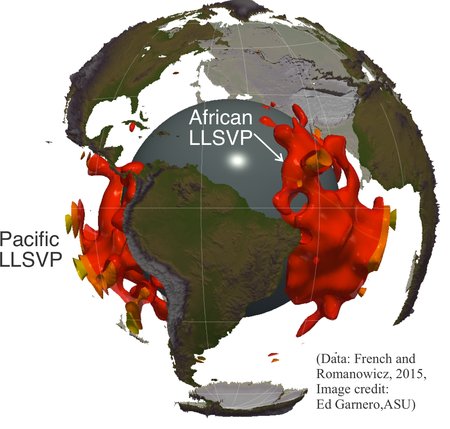2023-11-01 カリフォルニア工科大学(Caltech)

◆新しい研究によれば、これらのLLVPsは古代の地球との巨大衝突による残骸で、同じ衝突で月も誕生したとの仮説を提唱しています。また、月を形成する際の惑星テイアの痕跡が見つからなかった謎も、テイアの大部分が地球に吸収されてLLVPsを形成し、残りの破片が月になったことで解明された可能性が示されています。この研究により、地球内部プロセスに与える影響などの新たな研究の方向性が示唆されました。
<関連情報>
- https://www.caltech.edu/about/news/the-remains-of-an-ancient-planet-lie-deep-within-earth
- https://www.nature.com/articles/s41586-023-06589-1
月形成インパクターが地球の底部マントル異常の原因か Moon-forming impactor as a source of Earth’s basal mantle anomalies
Qian Yuan,Mingming Li,Steven J. Desch,Byeongkwan Ko,Hongping Deng,Edward J. Garnero,Travis S. J. Gabriel,Jacob A. Kegerreis,Yoshinori Miyazaki,Vincent Eke & Paul D. Asimow
Nature Published:01 November 2023
DOI:https://doi.org/10.1038/s41586-023-06589-1

Abstract
Seismic images of Earth’s interior have revealed two continent-sized anomalies with low seismic velocities, known as the large low-velocity provinces (LLVPs), in the lowermost mantle1. The LLVPs are often interpreted as intrinsically dense heterogeneities that are compositionally distinct from the surrounding mantle2. Here we show that LLVPs may represent buried relics of Theia mantle material (TMM) that was preserved in proto-Earth’s mantle after the Moon-forming giant impact3. Our canonical giant-impact simulations show that a fraction of Theia’s mantle could have been delivered to proto-Earth’s solid lower mantle. We find that TMM is intrinsically 2.0–3.5% denser than proto-Earth’s mantle based on models of Theia’s mantle and the observed higher FeO content of the Moon. Our mantle convection models show that dense TMM blobs with a size of tens of kilometres after the impact can later sink and accumulate into LLVP-like thermochemical piles atop Earth’s core and survive to the present day. The LLVPs may, thus, be a natural consequence of the Moon-forming giant impact. Because giant impacts are common at the end stages of planet accretion, similar mantle heterogeneities caused by impacts may also exist in the interiors of other planetary bodies.




